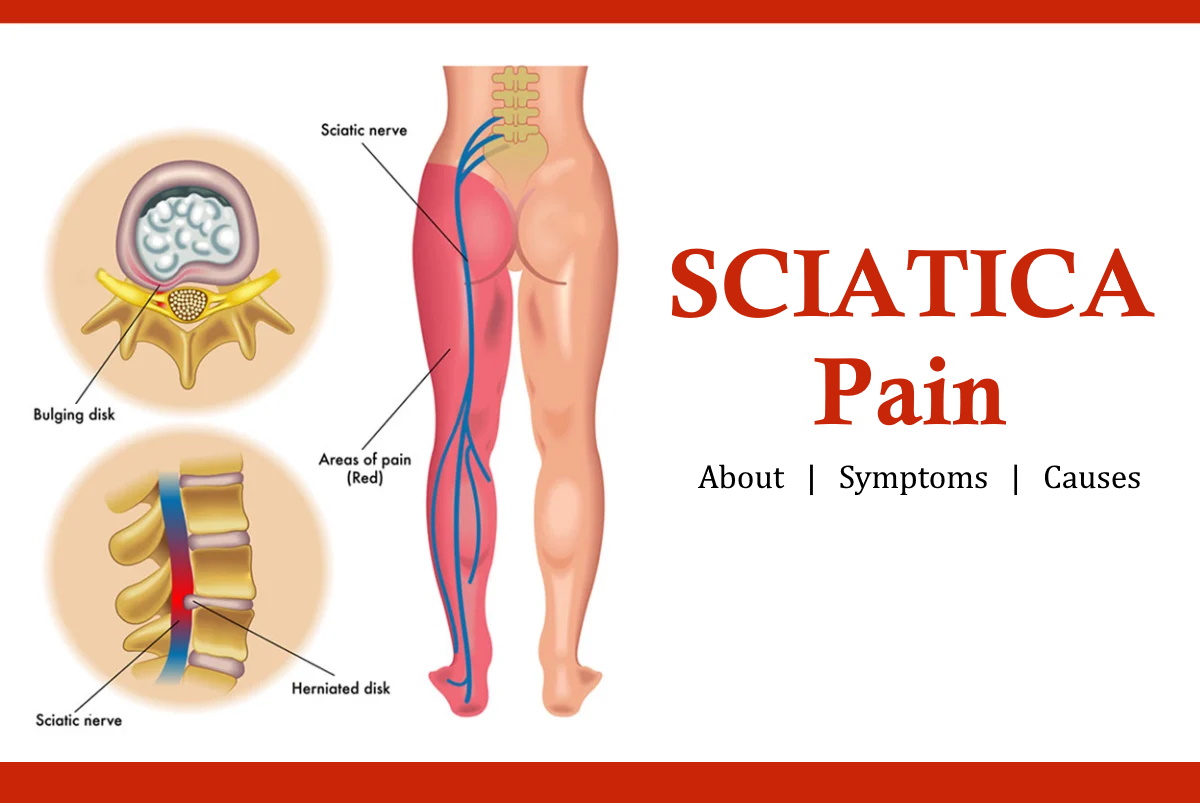What are the causes of Sciatica?
What is sciatica?
It can be defined as a continuously growing pain in the lower left or right leg that feels like a complicated interaction of nerve compression, which will result in more discomfort for you while sitting or standing. This illness, which generally begins in the lower back, has a unique pain pattern from the lower waist down to the whole foot.
Key aspects of sciatica:
- Nature of Pain: You will feel the pain for very acute timing, shooting, or burning pain that travels from the lower back down to the buttock and the back of one leg. The pain may increase with daily routine activities such as extended sitting, coughing, etc.
- Nerve Compression: Sciatica is mostly caused by compression of the sciatic nerve, the body's biggest nerve. This compression can be caused by multiple reasons, such as herniated discs, spinal stenosis, or bone spurs, resulting in the typical leg discomfort.
- Lower Back Origin: Sciatica pain starts at the roots of the lower spine. Herniated discs and spinal dislocations in the pelvic area can put pressure on the sciatic nerve, resulting in a slow and steady pain pattern.
- Complete Leg Affliction: The pain of sciatica, which is completely uncomfortable for the lower leg, runs from the bottom region of the waist down the leg, including the entire foot. This discomfort stands out from other types of leg pain due to its wide character.
- Aggravating Factors: Sciatic discomfort may increase during certain activities, such as extended sitting, standing, or rapid movements. Understanding and avoiding triggers are critical components of managing and treating sciatica pain.
- Numbness and tingling: Besides pain, people with sciatica may have numbness, tingling, or a "pins and needles" sensation in the affected leg. These sensory disturbances indicate nerve involvement.
- Severity and duration: Sciatica's impact might range in severity and length. While some people endure occasional discomfort, others suffer from continuous and severe pain. Early action is critical for successfully controlling symptoms.
- Diagnostic Measures: A thorough medical history, physical exams, and imaging procedures such as MRI or CT scans are frequently used to make a diagnosis. These diagnostic techniques help to discover the underlying problem and provide an effective treatment strategy.
Management and Treatment:
Sciatica treatment involves a variety of techniques, including:
- Medications include pain medications, muscle relaxants, and anti-inflammatory drugs.
- Physical therapy involves targeted exercises and stretches to relieve strain on the sciatic nerve.
- Heat and Cold Therapy: Use of hot or cold packs to relieve pain.
- Injections: Corticosteroids are used to decrease inflammation.
- Surgical Intervention: In extreme situations, surgery may be used to treat the underlying problem.
The symptoms of this pain develop slowly and mostly affect the lower back and legs:
- Gradual Increase in Back Pain: Patients usually experience a slow but steady increase of discomfort in the lower back, indicating nerve compression or irritation.
- Discomfort in the Back of the Leg: Another common symptom is discomfort that extends from the lower back to the back of the leg, indicating potential nerve involvement or sciatic nerve irritation.
- Pain in the Back of the Leg When Sitting: The discomfort increases when sitting, particularly in the back of the leg, highlighting the impact on everyday activities and posture.
- Groin Pain: Some people may feel thigh pain or hip pain in nearby areas, which may spread from the lower back or leg and add to their overall discomfort.
- Burning or Tingling Feeling in the Feet: Burning or tingling feelings in the foot may occur as a result of nerve compression or irritation along the sciatic nerve route.
- Pain on One Side of the Back of the Leg: The pain is usually unilateral, affecting only one side of the back of the leg, highlighting the location of discomfort.
- Intense Pain in Legs When Standing Up: Patients may have intense, shooting sensations in their legs when they stand up, indicating nerve compression enhanced by changes in posture.
Preventing sciatica pain involves adopting mindful practices and healthy habits.
Consider the following tips:
- Maintain proper posture: The first thing to keep in mind is that you should keep your back straight, whether standing or sitting, anywhere. This will help to improve your spinal alignment, lowering the possibility of nerve compression and sciatica discomfort.
- Exercise regularly: A patient who is suffering from the pain of sciatica has to perform some physical activities that strengthen core muscles and increase flexibility. This will not only improve general spinal health but also lower the risk of sciatica-related pain and suffering.
- Quit Smoking: Smoking can cause decreased blood supply to the spine, which accelerates loss of function and raises the risk of sciatica. Quitting smoking is an active strategy to prevent sciatic pain.
- Weight Management: As we all know, excessive weight gain causes multiple diseases, which will put stress on your spine and nerves. Maintaining a healthy weight reduces the pressure on the sciatic nerve, lowering the risk of getting sciatica.
In case of increased pain, contact a Neuro Specialist.

